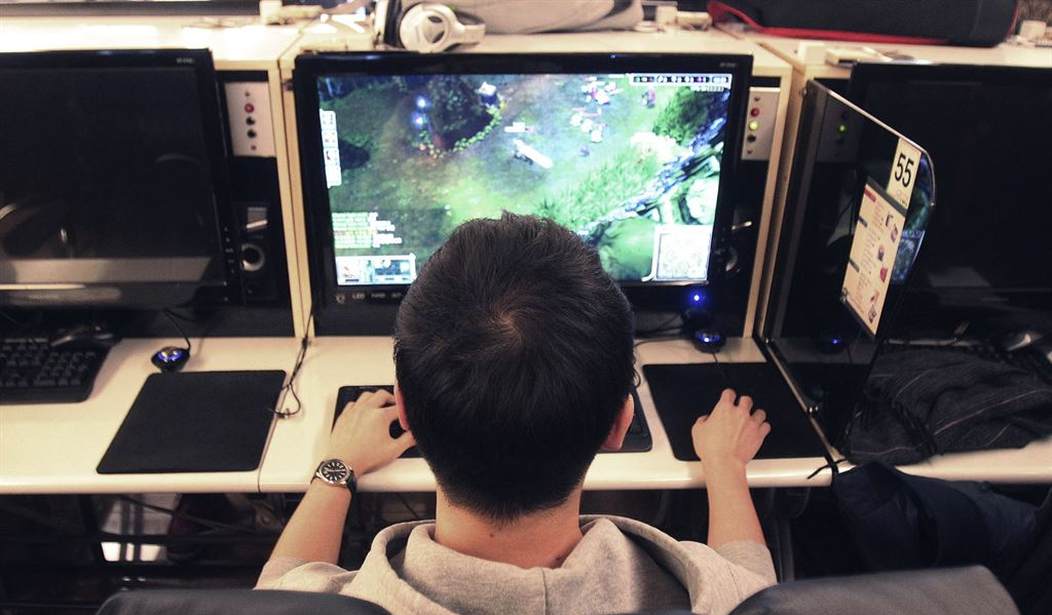Earlier today, we talked about how a Senior Editor at Kotaku claimed that one can’t be racist against white people. That was in the context of defending that website’s article trashing people objecting to a company called ‘Sweet Baby, Inc.’ What is Sweet Baby, Inc. and why is it controversial right now? I think these two videos from Midnight’s Edge and The Critical Drinker do a pretty good job explaining the controversy.
I would add two things to that discussion. First, it seems that a huge part of why the controversy blew up is what people call the Streisand Effect and its worth taking a moment to explain what a 'Streisand Effect' actually is.
The basic idea of The Streisand Effect is that when someone tries to suppress information—particularly by using government power—it calls attention to the information they are trying to suppress. This is not a thing anyone intentionally causes. It is how suppressing information can backfire.
The reason why it is named after Barbara Streisand and a pretty good example of this phenomenon is explained by the website Know Your Meme:
https://t.co/N2WHNbJZBz pic.twitter.com/fsXJKnP0BK
— The Hypocrisy Hippo (@HypocriscyHippo) January 31, 2022
That site explains the story behind the term as follows:
In 2002, photographer Kenneth Adelman took more than 12,000 photographs of the California coastline in an effort to document coastal erosion as part of the government-sanctioned California Coastal Records Project. One of the photographs taken showed an aerial view of Barbara Streisand's Californian mansion …
According to the Californian Coast Line official website, the organization received its first cease-and-desist letter from Streisand's attorney in February 2003, shortly after the launch of the site and the online gallery. A $50 million lawsuit was filed against the photographer and other suits were filed against the image hosting services Pictopia and Layer42 on May 20th, 2003. The filing of lawsuits was soon reported in the news media, which inadvertently led more than 420,000 people to the website, according to the California Coast Line website. …
In fact, prior to the lawsuit, only six downloads of that frame were executed (out of a total of over 14,000 downloads for the site as a whole), two of which were downloads by her own attorneys. Similarly, prior to the lawsuit, only three reprints of the frame were ordered through Pictopia – two by Streisand herself and one by a neighbor who is in a lengthy dispute with her over controversial expansion plans for her blufftop estate.
(Footnotes and internal quotation indicators removed.) So, if you are Barbara Streisand, this is the worst of all worlds. If she didn’t want people looking at pictures of her mansion on that site, the best thing she could have done was just ignore the website. Instead, by raising a fuss, she made herself look like an anti-free-speech thug, she lost the case, she wasted money on her lawyers, and she drew massive attention to the thing she didn’t want people looking at in the first place. Indeed, this whole story has been repeated many times, in order to explain to people what the term 'Streisand Effect' actually means. I wouldn’t be shocked if one of our readers actually looks up the picture in question after reading this article.
And by trying to suppress criticism of Sweet Baby, Inc., they drew attention to their critics’ argument and indeed, made their thuggish behavior a valid part of the story.
The other thing to note with these Sweet Baby, Inc. videos is I have to quibble on one thing. I am pretty sure that the recent game 'Suicide Squad: Kill the Justice League,' didn’t fail purely or even mostly because of DIE (Diversity, Inclusion and Equity) considerations. Now, I haven’t played the game, because the reviews made it pretty clear that this isn’t a game that I would like for reasons that had nothing to do with this DIE stuff. Chief among those reasons is that it’s what is called a 'live service' game and the public has been rejecting all but a few of those games for many years, now. I could go into all the things people don’t like about live service games, but I’ll simply say that many gamers will immediately reject a game when they know it is a live service title. In the last few years, a lot of good game companies have crashed and burned by trying to make live service games, and it’s legitimately distressing how many great game companies have been lost to this folly.
But, aside from that quibble, I think those videos explain the issue pretty well.
In any case, I wanted to take some time to talk about what I think the real objection is to diversity 'in front of the camera.' And while the Sweet Baby, Inc. controversy started this discussion, I'm not going to limit my complaint to games made with their ‘help.’ Instead, I'll get at the larger issue of the lame way diversity is handled in modern media.
I am a gamer and one of my favorite games of recent years is ‘Ghost of Tsushima.’ That game takes place in 1274 A.D., and you play Jin Sakai. Jin is a samurai living his best life on Tsushima, an island between the Korean peninsula and the main island of Japan, when the Mongols invade his home. This is (loosely) based on a real historical incident where the Mongols attempted to take over Japan, but were thwarted by a hurricane. The Japanese called the typhoon 'divine wind' because they believed that the gods literally saved them with that storm and in Japanese that is called Kamikaze.
(And in case you were wondering, Japanese suicide pilots invoked this history and religious belief during World War II.)
In any case, the game centers on how Jin becomes a legendary figure to the residents of Tsushima (the 'Ghost') and how, in desperation, he uses increasingly dishonorable tactics to fight the Mongol invaders. Its story is very good historical fiction. Here’s a trailer for that game.
And you know what was nice about that game? There are no white people in it. Unlike the movie 'The Great Wall' from a few years back …
… the only two ethnicities in the game are Japanese and Mongolians. And we all know why they find some way to insert Matt Damon into a movie about Chinese people fighting mythical monsters in ancient times: Because they think that ‘Western Audiences,’ won’t be as likely to watch a movie without a white guy in the lead.
Now, I'm not against white people (especially since I am one of them). But the problem with putting white people into this game is that it would be immersion-breaking. Ages ago, I was taught that one of the worst things you can do when creating any fiction is to make the reader remember that they are viewing fiction. Like if you are writing a novel, you want the reader to forget that they are reading a novel: You don’t want them to see the 'author’s hand' as they read it. If you are making a movie, you want the audience to forget that they are watching a movie and not see the 'creator’s hand.' If you are making a game, you want the gamer to forget he or she is playing a game. So, if you are playing, viewing or reading any kind of historical fiction about the Japanese and Mongols fighting in the thirteenth century and then an ahistorical white dude shows up, you are immediately taken out of the story. You think to yourself 'they just put this in to appeal to western audiences' and you suddenly remember that you are witnessing an artificial story that someone else made. But the historical fiction in ‘Ghost,’ leaves every other ethnicity out, and makes the story feel that much more authentic and immersive as a result.
Let me talk about another game series I like a lot: The 'Horizon' series. There are three games in the series, so far: 'Horizon: Zero Dawn,' 'Horizon: Forbidden West,' and the virtual reality game 'Horizon: Call of the Mountain.' I’ve only played the first two, because I don’t have VR. But let me provide a warning that there will be SPOILERS for the game series because a huge part of the first game is the mystery of what the heck is going on in the world and I’m about to tell you what was going on, because it is critical to understanding a complaint I have about the game. So, if you don’t want that mystery spoiled stop reading, now.
Still with me? Okay, much of the first game, ‘Zero Dawn,’ is centered around solving the 'mystery' of the game world. With very little context, your character is born into a 'post-post apocalyptic' world—meaning a world where there was a huge civilizational collapse, but it was so long ago, the world had mostly moved on. Humanity has been reduced to basically tribal status. They have no cars, or trains or even horses to ride on. However, there are also robots everywhere, and they are modeled after various living and extinct animals. Mysteriously, most of the robots are carrying on their own tasks for their own reasons and are completely indifferent to humanity. If you don’t bother them, they won’t bother you. Here's a trailer for that game:
(Please note that while you see Aloy riding a machine, she is the only one who can do this. That will be important to this discussion in a moment.)
As the story progresses, you learn that it is about a thousand years from our time. In their world, within about fifty years into our future, there is a robot apocalypse. That is, robots started destroying all life on Earth and when I say 'all life' I mean exactly that. They were not only killing humans, but they were killing everything down to plants, moss and bacteria. The Earth would be a dead rock when they were through with it. The humans tried their best to stop the robots, but as the war progressed, some humans figured out that the robots would definitely win and started to come up with a way to snatch victory from that defeat.
So, they came up with a plan, called 'Zero Dawn' and it went as follows. After the robots wiped out all life on earth, the bad robots would shut down automatically. After that, good robots would come out and re-introduce life, in essence terraforming the Earth back into a state where it could sustain human life, and then introduce humanity back into the world.
According to a fan wiki, humans were reintroduced into the world at around the year 2365 A.D. The events of the first game, Zero Dawn, takes place around the year 3040, so about six hundred years later.
I like the game, but there is something about it that gets on my nerves because it breaks immersion: All the races are represented and they are both integrated and separate at the same time. This is a world where no one remembers the history that existed before the robot apocalypse and racism doesn’t seem to exist. This story takes place geographically where America is now, and the good robots that reintroduced the human race into the world apparently did make sure to include the different races and ethnicities. So, the different races are integrated. Every single tribe has a mix of black, white, Asian and so on.
In other words, you see a mix of different races, but you know what you don’t see? A mix of the races themselves. You don’t see children who are mixed. I have played through ‘Zero Dawn’ and I think I am close to the end of ‘Forbidden West,’ and I can’t recall seeing a single mixed-race person in the whole game. Again, it’s been six hundred years since humanity has been reintroduced into the world and there is no hint of racism among any of the characters in the game that I have seen, but still apparently black people only have children with black people, white people only have children with white people, and so on.
I am of the opinion that if you took a group of people with roughly the demographics we have in America today and you eliminated racism, then within at most a thousand years, all of the people living here would be a nearly identical mix of the races. There effectively would be no races anymore. And honestly, I doubt it would take even that long. So, in 600 years, that process should be really far along—and yet, in this world, that process doesn’t seem to have started.
Because to the midwits who go on and on about diversity, 'diversity' means making every fictional world look like the demographics of what they think your average modern American city looks like, whether that actually makes any sense in the fictional world or not. They apparently have no idea how to actually deal with race in an intelligent, scientifically logical way.
The reality is that transportation barriers matter when it comes to diversity in a fictional world or in the real world. If you are doing a movie about the Battle of Hastings in 1066 A.D., one of the most significant battles in English history, and you are being historically accurate, you probably aren’t going to see any black people, Asians and so on. Why? Because transportation was ridiculously difficult back then. In the dark ages, the vast majority of people were born, lived their entire lives and died, within a five-mile radius. It wasn’t impossible for a black person or an Asian to make it to London, England about a thousand years ago, but it was extremely dangerous to make such a trip and almost no one did it. Every now and then you hear of outliers. Probably the most famous was Yasuke, the (black) African samurai in sixteenth century Japan. But people like him are very much the exception, not the rule and, in Yasuke’s case, that is approximately five hundred years later with transportation being slightly easier than it was in 1066.
I’m not saying every culture has to be portrayed as 'pure.' I have thought for years that someone could probably make a very interesting movie about the life of Yasuke and one question that I think would be fascinating is the racial attitudes he might have confronted. I mean, the Japanese were often extremely hostile to foreigners.
That issue was also the center of the story in the excellent Netflix cartoon 'Blue Eye Samurai.'
Again, I will warn you of minor SPOILERS (turn back now) …
… but as best as I can tell, that story was almost entirely fiction, but it is set in seventeenth century Japan and centered around a samurai who was blue eyed because she was part white. And the samurai was a woman in disguise as a man named Mizu. She sought revenge on the only three white men in Japan at the time she was conceived because she believed one of them was her father and she literally wanted revenge for being born. In short, she hates being part white—and the show correctly depicts this as an unhealthy sentiment. But the key element is that this is handling the issue of race intelligently and logically. It was in the seventeenth century, when Europeans were in fact reaching out to trade with Asia, but Japan officially banned foreigners. So, they imagined that there were non-Japanese people in the country being secretly tolerated by the government, but not very many, and they were definitely the exception, not the rule. And it was a reasonable fiction based on what we know about the world at the time. It could have been true, even if it literally wasn’t.
(By the way, as a warning to parents, Blue Eye Samurai is one of those cartoons that is not appropriate for kids. Not only is the show pretty violent, but it also has a ton of nudity and sex. I’m not putting it down but I am aware that many parents just assume every cartoon is fine for young kids and this one definitely isn’t. I recommend that you watch it, but not when your kids are around.)
Even in Kevin Costner’s ‘Robin Hood: Prince of Thieves,’ they introduced diversity in their world in a rational way that made sense. As you might recall, Morgan Freeman played Azeem Edin Bashir Al Bakir. As I understand it, this character was made up for the movie—he was never part of the Robin Hood legends—but they took the time to make his inclusion make sense, with the character meeting Robin during the crusades and following him home, because Azeem felt he owed Robin a debt. Thus the movie did a good job explaining how and why a black dude was walking around in twelfth century England.
That’s one way to do diversity right and here’s another: Tell stories from other cultures. For instance, I really enjoyed the movie 'Moana,' and one thing I always say about it is this: When I was growing up, I would hear all these stories from Greek Mythology, and I always thought 'I’m sure there are other cultures that tell their own mythological stories. Why don’t we hear anything about them? I’m sure some of them either fun or interesting.' Well, Moana was pretty much exactly what I had been asking for all those years back: A story based on Polynesian mythology, not very different from the kinds of stories you would hear in Greek mythology, but it was something I had never heard before, it was well-told and I had a great time watching it.
And much like with 'Ghost of Tsushima,' it was welcome that the creators of Moana didn’t try to shoehorn in a character who wasn’t Polynesian into it. The closest you come is a giant crab with an English accent, but that was a crab. While mythological, this movie was based on myths about a historical period where that part of the world was overwhelmingly dominated by the Polynesian people and to bring in people of any other ethnicity would be out of place. They could come up with some kind of story to explain it, or they could just avoid getting bogged down on the issue and I think they made the right decision by keeping the story Polynesian.
And so that’s a different way to create diversity, overall. You have one story that takes place in medieval Europe and is all about white people; another takes place in ancient Africa and stars black people; a third takes place in ancient Persia and stars Persians; and so on, creating diversity overall, rather than artificially cramming it into one story in a time and place where diversity didn’t actually exist.
In the end, gamers aren’t by nature more racist than most people—and most people aren’t racist, either. You never heard of gamers complaining about diversity, for instance, in the Grand Theft Auto games. Each of the worlds you go into in those games look like the demographics of your average modern American city because they literally take place in parody versions of our modern cities. If you booted up Grand Theft Auto IV and saw that Liberty City—a parody of New York City—and everyone on the streets was white, that would be pretty questionable from a racial perspective. Gamers don’t object to diversity in and of itself. They object to how it is handled in woke storytelling.
At the risk of projecting my perspective onto other gamers, I want to feel like I am in the world they are creating and to feel like that world makes sense. That’s how you get escapism. I like to forget that I am playing something that took many people a long time to create. I want the hands of the games’ creators to disappear. I don’t mind diversity. In fact, in the right context, I expect diversity. And for the love of God, give me stories from different cultures. Sure, I like the Tolkien style European fantasy, but I would love to see a version of that kind of world where instead it is based on African fantasy, Native American fantasy, Asian fantasy or whatever. One of my favorite games in the last few decades was Final Fantasy X, which I am told is based on Okinawan culture. What I think most gamers (and consumers of other media) want is for the creators to handle these issues logically, in a way that makes sense given what we know.
And that is just about handling diversity 'in front of the camera.' I think gamers want the people 'behind the scenes' involved in creating these games to practice equal opportunity so that creators of all colors and backgrounds have a shot at helping to create the next great game. Let the best person make the games, regardless of color or other irrelevant factors. But their approach to diversity 'in front of the camera' is too often emblematic of their attitude about diversity in general: Ham-fisted and at the expense of actual quality. And that’s what I think gamers are objecting to.

























